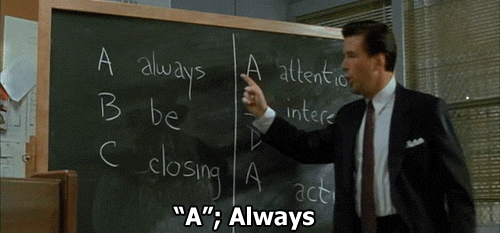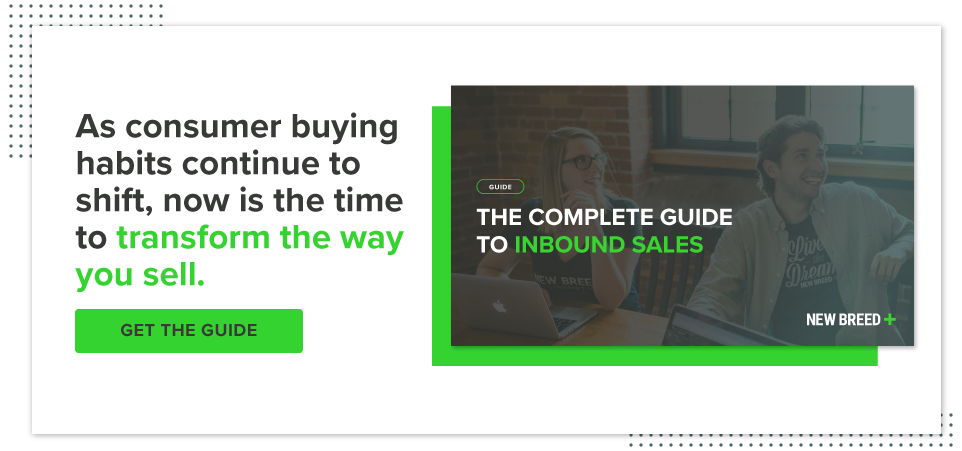
The idea of sales reps needing to be “closers” has always been a part of sales culture. If you’re a sales rep that can’t close, you’re not going be successful, and that’s still true today. You still need to be able to close a deal, but the journey to the closed sale has changed.
According to HubSpot, 47% of buyers viewed 3–5 pieces of content before even deciding to speak to sales, and with that increase in independent research, the way buyers depend on sales reps has changed. Salespeople aren’t the only source of information anymore.
When you get the opportunity to finally engage with a prospect, rather than telling the prospect about the features of your product or service, focus on educating them how your solution can help them and the rest of their company and any organizational changes that’ll be needed for optimal benefits as a result of purchasing your solution.
The goal of sales now is to empower the buyer and make the decision to buy as easy for them as possible. Instead of focusing on selling to buyers, you need to flip your mindset to focus on how the buyer makes a purchase from you.
Provide them with any info they need to make a decision and build trust throughout the process so when it becomes time for the buyer to make a decision you’re in a strong position to go for the close.
The inbound approach is at the center of this mindset shift: instead of pushing unsolicited information onto leads and prospects, inbound sales focuses on drawing high-fit buyers in, empowering them with educational content, and supporting them through their decision-making process.
When a lead comes to you through means of inbound content like email, social media, or organic search, you’re already armed with those data points to personalize your sales conversation.
You know what pieces of content they’ve accessed, which website pages they’ve visited, what social posts they’ve engaged with and consequently, how to tailor your conversation to meet them where they are in the buyer’s journey.
Instead of starting a conversation by introducing the generalities of your product or service, you can start talking about specific posts they’ve interacted with and the solutions you have for the pain points people checking out that post normally have.
Taking an educational approach to the sales process enables you to not just close a deal, but generate a brand evangelist. Instead of pushing your product or services from the start, help prospects understand the value of what your solution accomplishes so they want to buy it.
The “Close” Hasn’t Left the Sales Process, But the “Always” Has
Instead of focusing exclusively on closing for the sake of closing. Focus on supporting and educating prospects who will find long-term value in your product. And as long as you engage in the latter, the former will follow.
If you focus only on selling, you might sell to a poor-fit lead who can’t really gain value from your product or service. That will lead to them being an unhappy customer who will likely churn and share their poor experience.
It might be difficult to give up a potential sale, but leading a prospect toward an alternative offer (that is ideally not a competitor) if you’re not the best solution to meet their needs can lead to a positive experience nonetheless.
Avoid this fallout by ensuring that you have a solid understanding of the firmographics of a customer with a high lifetime value looks like for your organization. Sometimes a company needs to grow in size, sophistication or product-offering before they can benefit from your product or service.
For example, a small startup might not be ready for HubSpot’s full marketing hub but might be able to gain value from using their free marketing tools like forms and conversational bots.
Instead of selling them something they don’t need, make a recommendation for where they can start and when they might be at a point where they can benefit from your product or service. Then when they get to the point that they’re ready to come back, they already know you have their best interests in mind.
That startup is going to be a lot more likely to upgrade to a paid version of HubSpot if they’ve been gaining value from the tool as they grew, whereas if they started paying for it before the functionality was really useful for them, they might have written it off as an unnecessary expense and churned.

Only to selling to good-fit needs isn’t just a responsibility of individual sales reps though. For sales reps to turn down poor-fit prospects, their goals and incentives need to be structured in a way that they don’t feel like they have to close every single person they talk to.
A Change in Process
The inbound sales process starts with the buyer doing independent research as they become aware of the challenge they have. The buyer then comes across a piece of your content, maybe a blog post, so they decide to read it. If they find the post valuable, they might click the CTA and fill out a form to download one of your premium content offers. Then they’ll be enrolled in a nurture track and continue to engage with your content until they decide to follow up with sales or you reach out the start that sales conversation.
The buyer will enter that conversation with preconceived notions of what they need and how you can help them. If you’ve been tracking their digital body language and researching their role and their company, you might have a good idea of what those notions are too.
While you should focus your conversation around helping them, you should also be ready to challenge the buyer’s assumptions.
A prospect might know they need a CRM to help with their contact management but hasn’t thought about how marketing automation or a website integration will come into play. You might then challenge their assumptions and point out that in addition to the CRM, they also could benefit from some integrations, an implementation service or something else your company can help with.
That challenging of assumptions is an important piece of the sales process — it’s why the challenger sales method is so successful.
When a sales rep focuses on helping, they don’t have to throw out all their existing sales methods. Helping can include educating, challenging and providing value in other ways.
Switching the focus from closing to helping isn’t a change in methodology; it’s a change in process and how the close fits into the sales process.
Guido Bartolacci
Guido is Head of Product and Growth Strategy for New Breed. He specializes in running in-depth demand generation programs internally while assisting account managers in running them for our clients.





